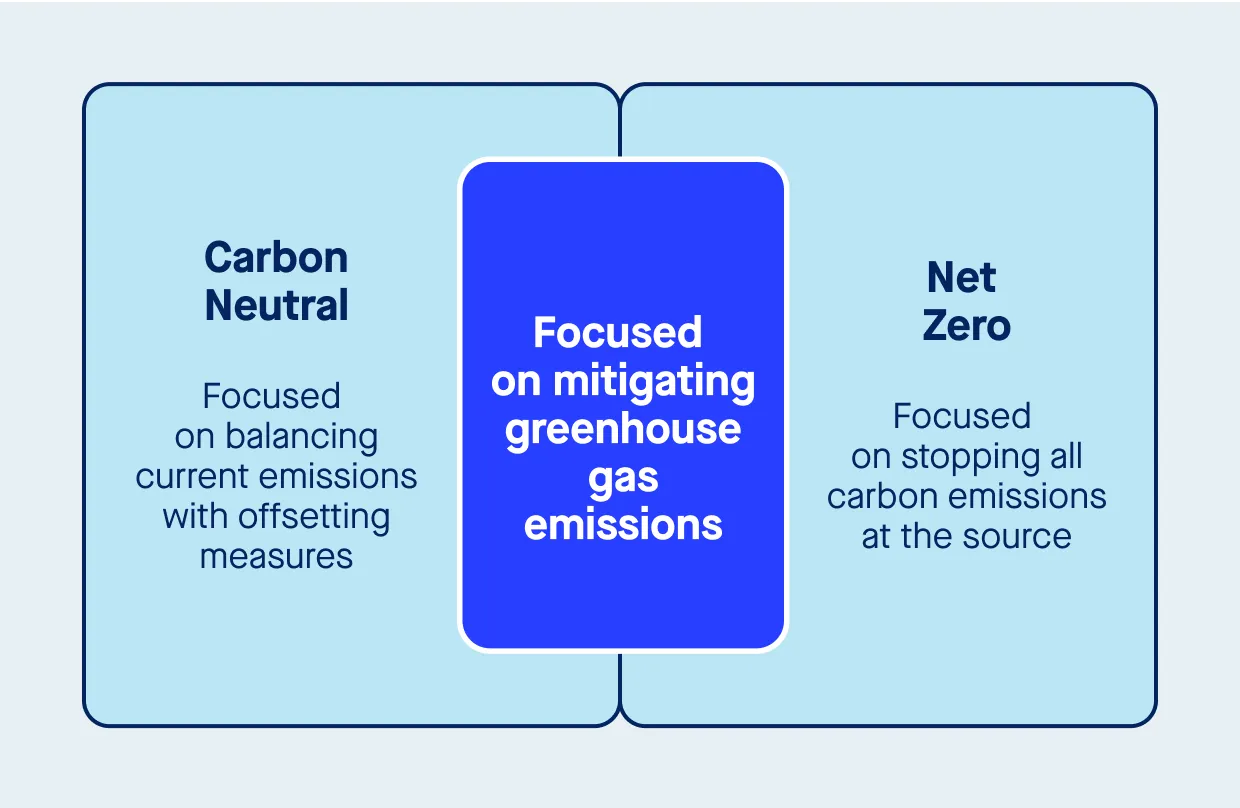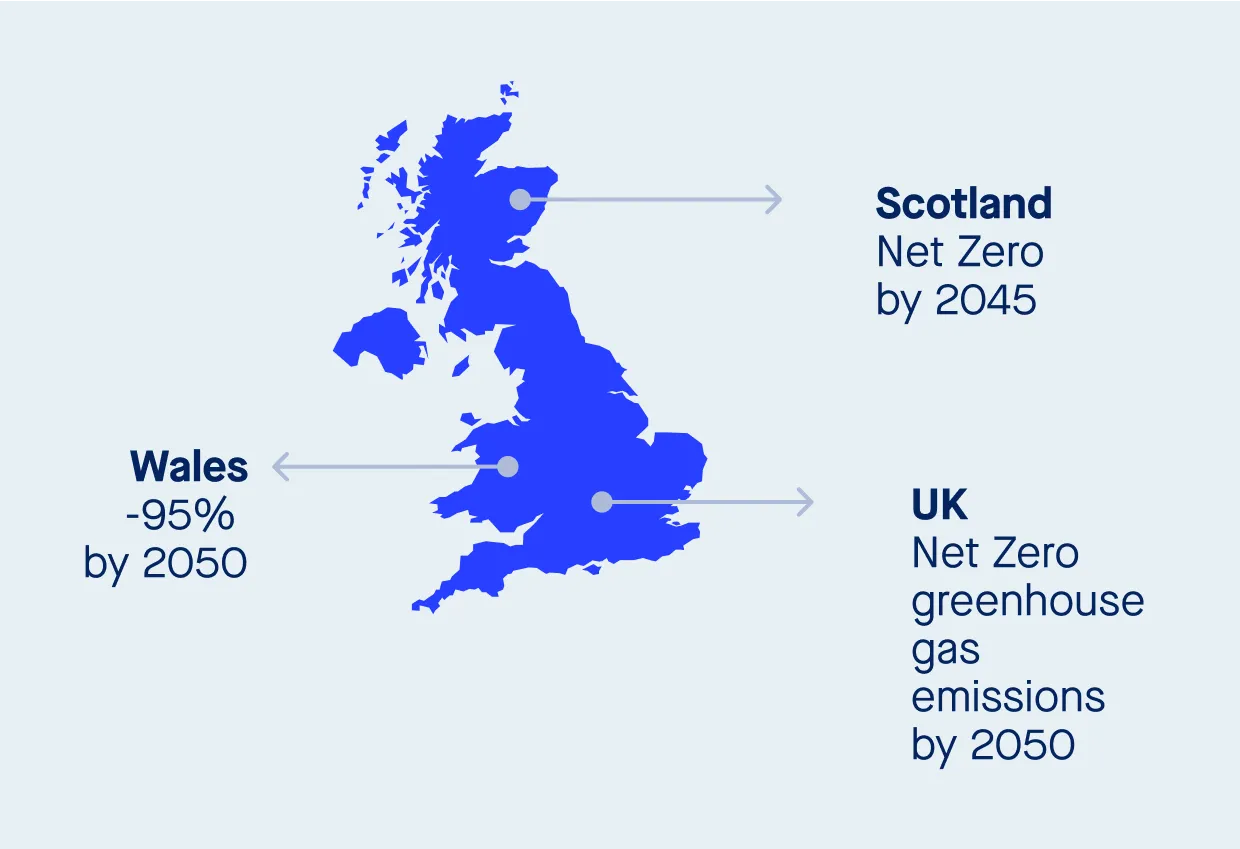What does net zero mean?
Net zero means balancing the greenhouse gases emitted into the earth’s atmosphere with those removed. In practice, this means reducing carbon emissions as much as possible and offsetting any remaining emissions through methods like carbon capture or reforestation.
Greenhouse gases, primarily carbon dioxide, trap heat in the earth’s atmosphere, causing global temperatures to rise. This is a leading driver of climate change. Reaching net zero aims to stabilize global temperatures by eliminating the excess emissions that contribute to this warming.
The UK government’s ambition is to not only cut direct emissions from public sector buildings by 50% by 2032 but to also create pathways for a sustainable economy by encouraging businesses and individuals to act collectively.
How is net zero different from carbon neutral?
While the terms “net zero” and “carbon neutral” are often used interchangeably, there are critical differences.
A carbon-neutral business offsets the emissions it produces—such as by investing in renewable energy projects or tree-planting initiatives—without necessarily reducing its overall emissions. For example, a company could continue emitting at current levels but pay for an equivalent amount of emissions to be removed elsewhere.
Net zero, on the other hand, goes beyond offsetting. It requires businesses to actively reduce emissions across their operations and value chains, ensuring that minimal emissions remain before offsetting. This approach aligns with global efforts to reduce overall greenhouse gas emissions and limit the damage caused by climate change. The UK’s greenhouse gas emissions targets, such as an 80% reduction from 1990 levels by 2050, highlight the importance of credible policies and actions as part of the Paris climate agreement.
The Climate Change Committee recommends focusing on net zero strategies over carbon neutrality, as the former addresses the root cause of emissions rather than relying heavily on offsets.

UK’s Greenhouse Gas Emissions Targets
The UK has set some of the most ambitious greenhouse gas emissions targets in the world, aiming to reach net zero by 2050. This commitment is driven by the urgent need to tackle climate change and limit global warming. According to the Climate Change Committee (CCC), the UK has already made significant strides, achieving a 50% reduction in territorial emissions since 1990. This progress is a testament to the effectiveness of policies and the collective effort of businesses and individuals.
However, the journey to net zero is fraught with challenges. The CCC highlights that sectors such as transport, buildings, and agriculture still lag in emissions reductions. The UK’s targets include a 68% reduction in emissions by 2030 compared to 1990 levels and cutting emissions from energy supply sectors by 75% by 2030. Additionally, there is a goal to reduce emissions from transport, buildings, and agriculture by 50% by 2030.
What does the net zero target mean for businesses?
The UK government’s net zero target is designed to accelerate climate action across all sectors. Businesses are key to achieving this ambition, especially since small and medium-sized enterprises make up 99.9% of the UK business population.
Governmental actions and investments, such as the £410 million investment in fusion energy, are crucial for enhancing energy security, ensuring a reliable and sustainable energy supply.
Taking action on net zero offers businesses a range of benefits, including:
- Lower running costs: Energy efficiency measures and sustainable practices can help reduce utility bills and operational expenses.
- New opportunities: Transitioning to green practices opens doors to innovation, new markets, and partnerships.
- Investor appeal: Customers and investors are increasingly prioritizing businesses with strong environmental credentials.
- Regulatory compliance: Meeting net zero targets ensures you stay ahead of tightening regulations like the Corporate Sustainability Reporting Directive (CSRD).
- Enhanced reputation: Businesses taking credible climate action will build trust and loyalty among stakeholders.
However, achieving net zero is not just about compliance or cost-cutting. It’s about transforming business operations to align with a sustainable future.

How can businesses set their own net zero targets?
Setting a net zero target starts with understanding your current carbon footprint. This involves measuring greenhouse gas emissions from all sources, including direct operations (Scope 1), energy use (Scope 2), and your supply chain and product lifecycle (Scope 3).
Here’s a step-by-step approach for businesses to set and achieve their net zero targets:
- Measure emissions: Use tools or platforms to calculate emissions across your operations and value chain.
- Set science-based targets: Align reduction goals with global standards, such as those recommended by the Climate Change Committee.
- Develop an action plan: Identify opportunities to reduce emissions, such as improving energy efficiency, transitioning to renewable energy, or switching to electric vehicles.
- Engage stakeholders: Collaborate with employees, suppliers, and partners to drive collective action.
- Track progress: Monitor and report your emissions reductions regularly to ensure transparency and accountability.
Businesses that adopt these practices not only contribute to reducing the UK’s greenhouse gas emissions but also position themselves as leaders in the transition to a greener economy.
Net zero starts with managing your business greenhouse gas emissions
Every business, regardless of size, contributes to the UK’s greenhouse gas emissions. Managing these emissions is the first step toward net zero.
For example:
- Premises: Improve energy efficiency by upgrading insulation, using energy-efficient lighting, or installing renewable energy systems like solar panels.
- Transportation: Transition to electric vehicles or optimize delivery routes to reduce fuel consumption.
- Supply chain: Work with suppliers to adopt greener practices and source sustainable materials.
By addressing emissions at every stage of your operations, you can make meaningful progress toward your net zero goals.
Achieving net zero can be complex, especially for businesses with intricate supply chains or limited resources. Carbon management platforms simplify the process, offering tools to measure, track, and reduce emissions effectively.
Here’s how these platforms can support your journey:
- Streamlined data collection: Centralize emissions data from across your business and supply chain for better visibility.
- Accurate tracking: Identify emissions hotspots and monitor progress against reduction targets.
- Regulatory compliance: Meet reporting requirements like the CSRD or Streamlined Energy and Carbon Reporting (SECR).
- Scenario modeling: Test reduction strategies to identify the most effective actions.
Carbon management platforms also provide businesses with insights to make informed decisions, helping them prioritize actions with the greatest impact on reducing emissions.
Selecting the right carbon management platform is key to achieving your net zero target efficiently. Not all platforms are created equal, so it’s important to assess your business’s specific needs.
Here are some tips to guide your decision:
- Identify your priorities: Consider whether you need basic carbon accounting or more advanced features like supply chain tracking, scenario modeling, and offset integration.
- Look for scalability: Choose a platform that can grow with your business and accommodate more complex reporting as your operations expand.
- Check compliance capabilities: Ensure the platform supports reporting frameworks like the Climate Change Committee recommendations, CSRD, or SECR.
- User-friendly interface: Opt for a tool that’s easy for your team to use, reducing the learning curve and ensuring adoption across departments.
- Integration options: Select a platform that integrates seamlessly with your existing tools, such as accounting software or procurement systems.
- Support and training: Assess the level of customer support, onboarding, and training offered by the platform provider.
Choosing the right platform can streamline your carbon management efforts, ensuring you stay on track with your emissions reduction goals while maximizing efficiency and cost savings.
UK Government Support for Businesses
The UK government recognizes the pivotal role businesses play in achieving net zero and has launched several initiatives to support this transition. One such resource is the Zero Carbon Business website, which offers practical measures for small businesses to cut their carbon emissions. Additionally, the SME Climate Commitment encourages small businesses to halve their greenhouse gas emissions by 2030 and achieve net zero by 2050.
The Green Finance Strategy aims to mobilize private sector investment in low-carbon technologies and infrastructure, ensuring businesses have the financial backing needed for sustainable growth.
To further support businesses, the government has announced several funding initiatives, including:
- £410 million investment in fusion energy: This funding aims to advance the development of fusion energy, a potential game-changer in clean energy.
- £51.9 million for emissions-cutting projects: Targeted funding to support innovative projects that reduce emissions.
- £1.5 billion for the Green Homes Grant scheme: This scheme helps businesses and homeowners improve energy efficiency, reducing overall carbon emissions.
These initiatives and resources are designed to help businesses navigate the transition to net zero, ensuring they remain competitive and sustainable in a low-carbon future.
Take action now
The UK government’s net zero initiative is not just a policy; it’s a call to action for businesses to help combat climate change. By managing emissions, setting ambitious targets, and leveraging tools like carbon management platforms, your business can thrive in a low-carbon future.
Taking action today positions your business as a leader in sustainability, ensuring compliance with future regulations and contributing to a healthier planet. Whether you’re improving energy efficiency or transitioning to electric vehicles, every step counts in reducing emissions and securing a sustainable future.






